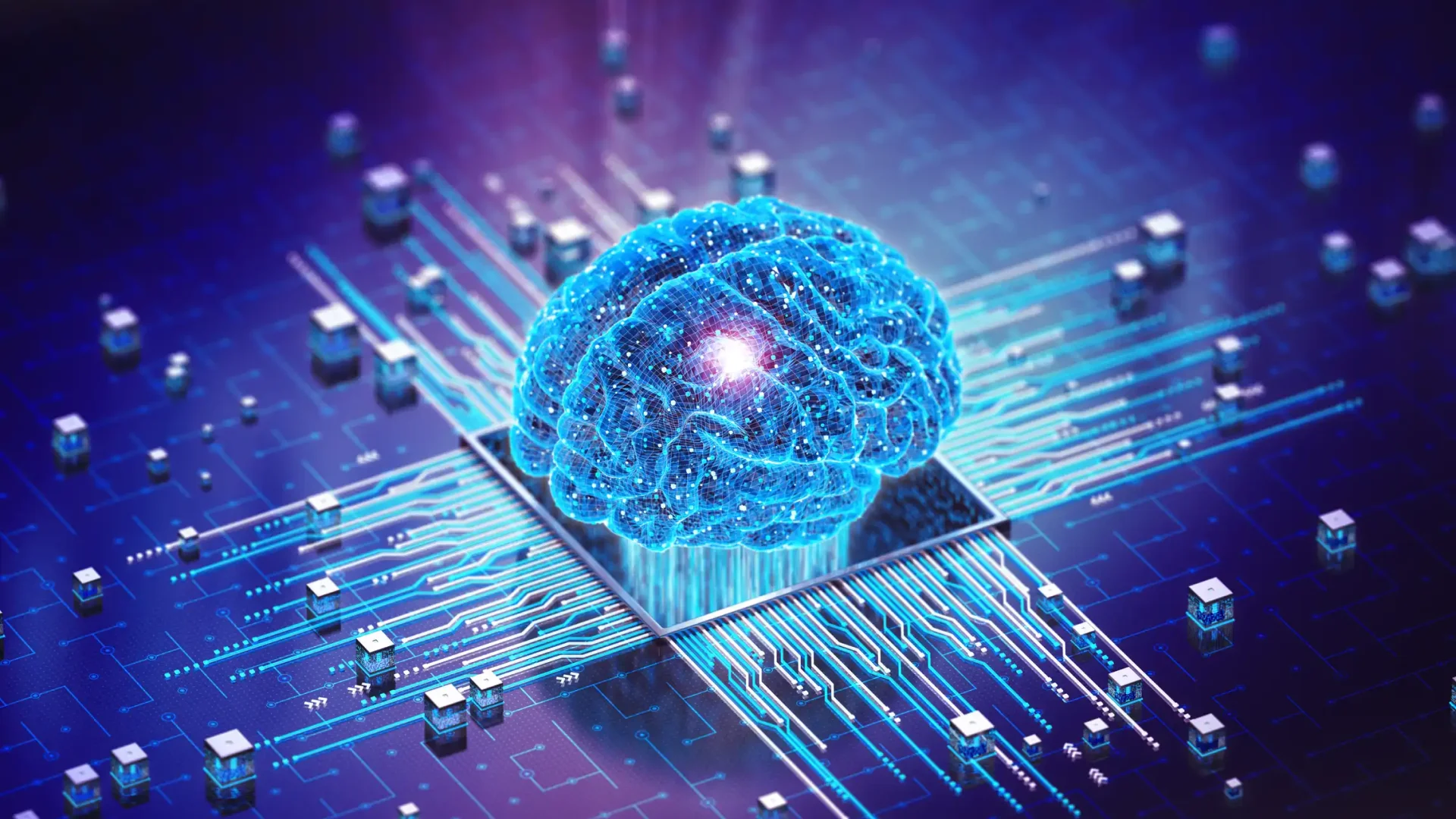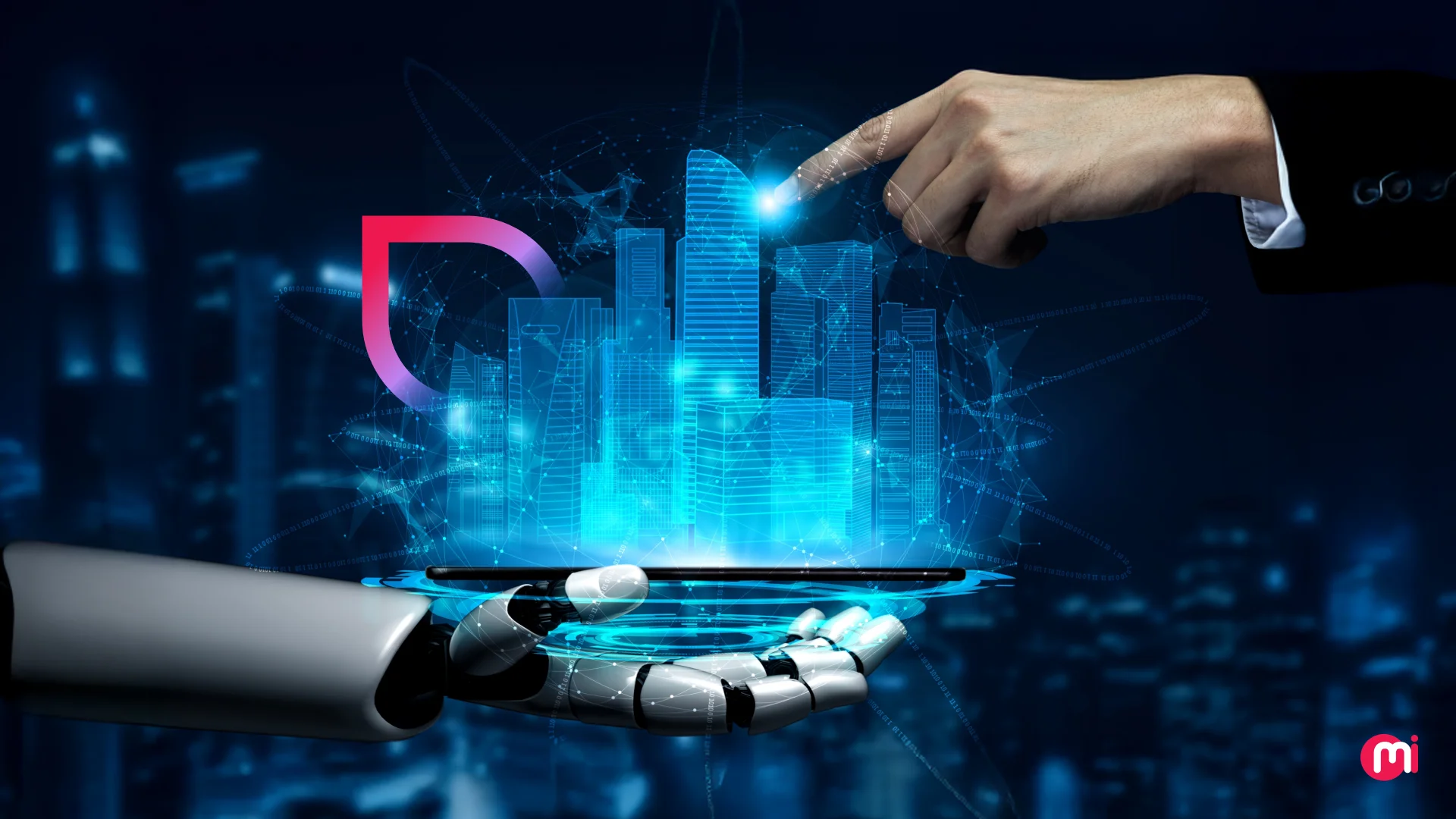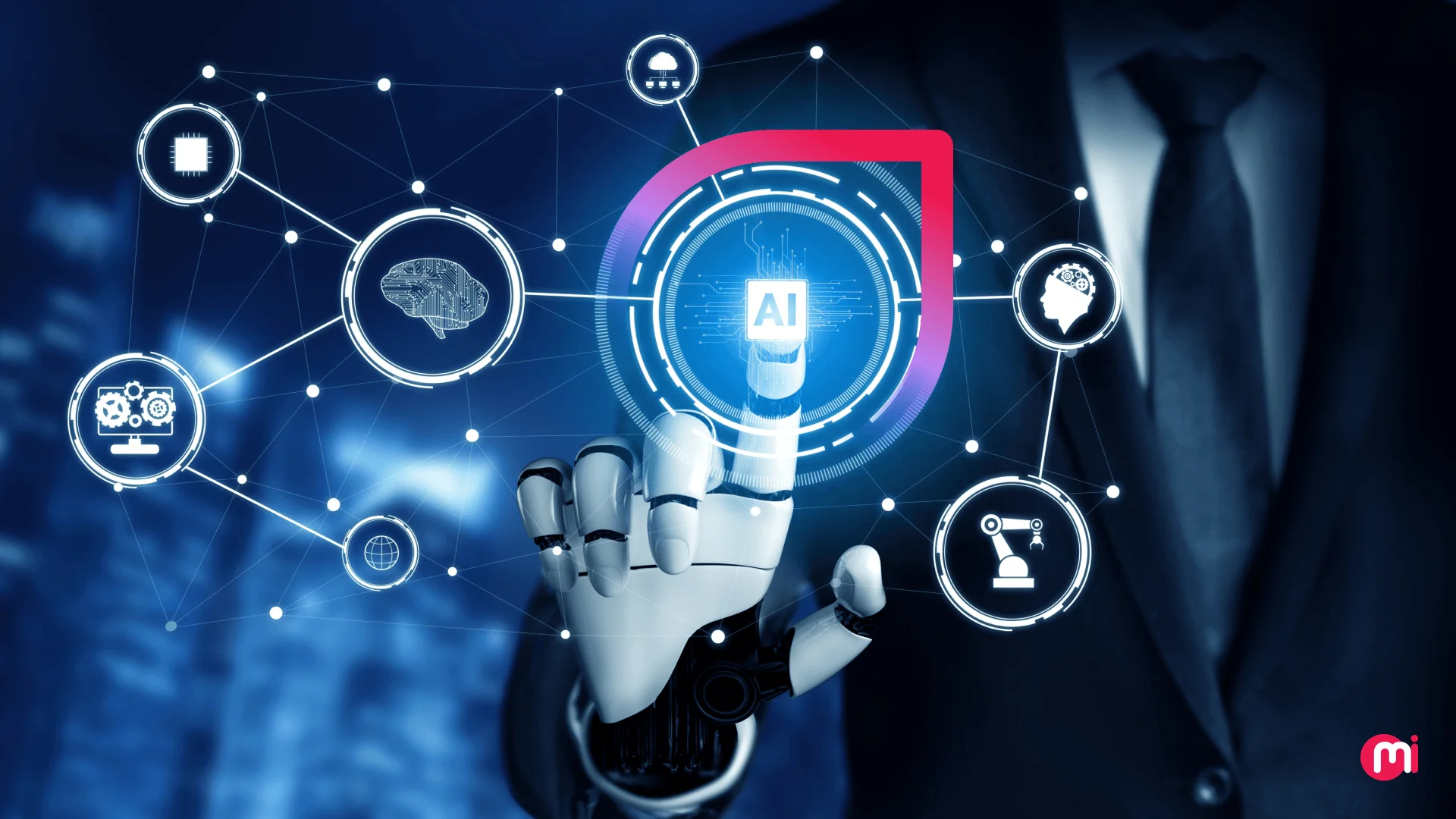How to Create A Powerful Generative AI Solution?
- AI/ML
- May 13, 2024
From its initial debut as a groundbreaking solution to capturing the attention of businesses, generative AI or generative artificial intelligence has rapidly risen to prominence. While it streamlines workflows, the journey to developing a generative AI powerful enough to deliver such results can be challenging for both developers and business analysts. That’s why we’ve crafted this blog to guide you through the entire process of how to create generative AI – from grasping the core concepts to following a step-by-step development approach and adopting best practices along the way.
From science fiction fantasy to practical reality, Artificial Intelligence is all the rage!
The intent to use the internet for information consumption has radically upended after Gen AI(generative Artificial Intelligence) became just about omnipresent because users are now generating the information from these Generative AI solutions instead of surfing search engines.
According to Salesforce’s most recent survey on generative AI use, 73% of the Indian population, 49% of the Australian population, and 45% of the US population are using Gen AI or generative AI.
From the potential to revolutionize drug discovery to being available for answers about any damn curiosity, generative AI solutions are being used extensively to an extent where the Salesforce survey mentions its consumers as “super-users”. It means that these users utilize Gen AI solutions frequently and are on their way to mastering it.

Now let’s have a look at the current market scenario and future projections of Generative AI.
According to Bloomberg Intelligence’s new report, the rising demand for generative AI products could add about $280 billion of new software revenue, driven by specialized virtual assistants, new infrastructure products, and copilots that accelerate coding.
As mentioned in the market insights on Generative AI by Statista, the market size is predicted to expand at a 46.47% annual rate (CAGR 2024-2030), resulting in a market volume of US$356.10 billion by 2030.
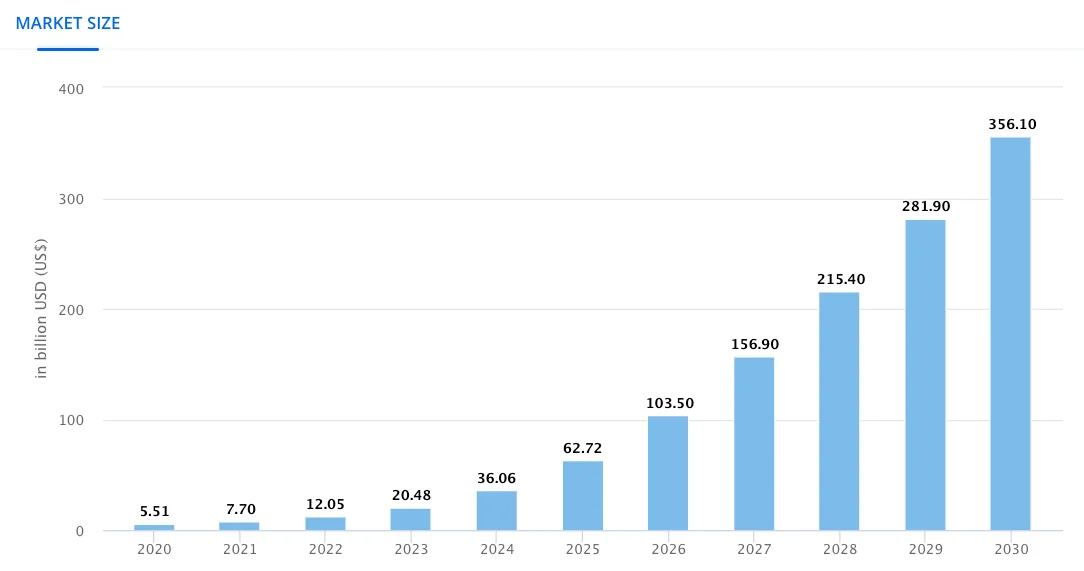
Gen AI or Generative AI solutions are a splendid business opportunity for startup owners and entrepreneurs who want to bootstrap their businesses. These numbers would definitely impress the venture capitalists too!
Before you hire an AI developer for building a Generative AI solution, let us first understand what it is and some of its fundamental aspects.
What is Generative AI?
Generative AI, also referred to as Gen AI, is a subset of AI, and it’s capable of generating content or data autonomously, such as text, images, entire datasets, and other content. It generates the content based on a variety of user input and trained data. Gen AI or Generative Artificial Intelligence is utilized in various applications, including image generation, text generation, and even the development of human-like chatbots.
Types of Generative AI Models
There are numerous generative Artificial Intelligence model types available, each designed for specific tasks and use cases. This diversity ensures that generative AI can be harnessed effectively in a wide range of applications, meeting the diverse needs of businesses and researchers.
Though a large language model dominates the market, here is the global generative AI market share by models.
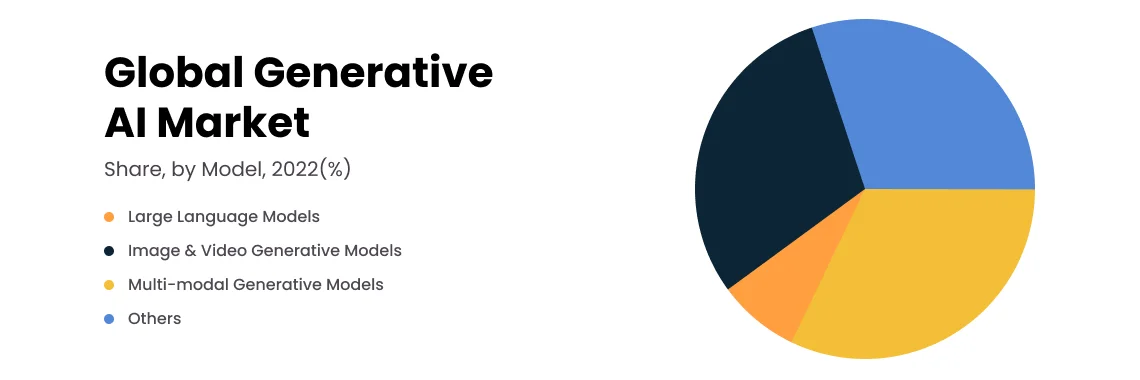
The choice of the right generative would directly impact the effectiveness of your Generative AI solution. From task suitability to interpretability and data requirement, each type of data model has distinctive characteristics. So let us now explore some of the most chosen Gen AI models.
Generative Adversarial Networks (GANs)
A type of deep learning model characterized by its adversarial structure, it comprises two neural networks, the generator, and the discriminator.
Imagine one is an artist(the generator) trying to make counterfeit money, and the other is an expert detective (the discriminator) trying to spot fakes. They work together by competing and improving. The artist keeps improving their counterfeit skills, while the detective gets better at catching fakes. As they compete, the counterfeit money (or data) created by the artist becomes so realistic that even the detective can’t tell it apart from the real deal.
This dynamic equilibrium results in amazing creations, whether it’s generating lifelike images, realistic text, or even style transfer. This is one of the best Generative AI models for generating images, text or style.
Large Language Models
These are advanced natural language processing systems designed with extensive neural networks and pre-trained on vast datasets to generate human-like text on a wide array of topics and tasks.
These Generative AI models have proficiency in text generation, translation, summarization, question-answering, offering practical applications, and even code generation.
While their capabilities are remarkable, they also raise concerns about ethical use, privacy, and responsible AI development, necessitating careful oversight and responsible implementation in various domains.
Diffusion Models
From helping computers understand complex things by breaking them down into simpler steps to making a blurry picture clear, this generative model is designed to estimate complex probability distributions over data.
Unlike traditional generative models, such as autoregressive or Markov models, diffusion models follow an iterative approach to progressively refine the data distribution.
This generative AI model works best in image synthesis, inpainting, denoising, data imputation, and more.
Variational Autoencoders (VAEs)
This generative AI model employs an encoder-decoder architecture to capture and generate complex data distributions. It harnesses the combined power of autoencoders and probabilistic modeling.
In a VAE, the encoder takes input data and maps it to a learned distribution within a lower-dimensional latent space. This process enables the encoding of complex data into a compact and continuous representation. The decoder then reverses this process, mapping data from the latent space back to its original form.
What sets VAEs apart is their power to not just reconstruct data, but to traverse a latent space of possibilities. VAEs are used to generate realistic images, art synthesis, audio, texts, anomaly detection, and more.
Transformer-based Models
Powered by advanced natural language processing and machine learning, transformer-based models demonstrate remarkable proficiency in language translation, text generation, information retrieval, and more.
The core innovation of transformers lies in their ability to parallelize the processing of data, thanks to the self-attention mechanism. Additionally, transformers excel in capturing long-range dependencies within sequences, making them highly adept at handling complex relationships and context in language.
Once you select the appropriate model for your Generative AI solution, it is time to build one.
How to Build a Generative AI Solution?
Building a Generative AI Solution is a structured journey, and this step-by-step guide on how to build a Gen AI soltution will walk you through the entire process. Each phase of this guide plays a crucial role in crafting a successful Generative AI solution. Read further to begin transforming your AI business idea into a Generative Artificial Intelligence based software solution.
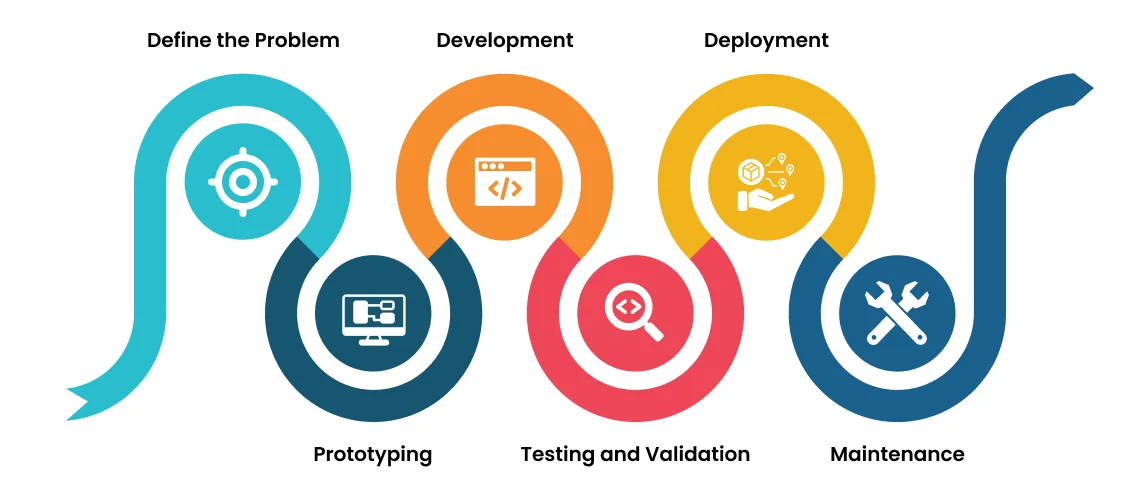
1. Define the Problem and Objective for Building Generative AI
First things first, it is the problem definition/statement that would determine the process of building a Generative AI solution. Problem definition/statement comprises the issues you want to solve by creative generative AI like style transfer, image synthesis, realistic images, and more.
2. Prototype The Generative AI Model
Prototyping involves building a simplified version of your AI model to test its core functionalities and assess its potential.Prototyping the Gen AI model enables entrepreneurs/stakeholders to visualize the AI system’s potential, identify potential challenges, and iterate on the design as needed. Prototyping enables stakeholders to visualize the AI system’s potential, identify potential challenges, and iterate on the design as needed.
Data Collection and Preparation
The collection process requires meticulous sourcing of high-quality data, ideally representative of the problem domain, and may include text, images, or other relevant data types. Once gathered, the data undergoes a rigorous preparation process. This entails cleansing, formatting, and structuring the dataset to eliminate noise, errors, and inconsistencies.
Proper data standardization and normalization are vital to ensure that the model can generalize across various inputs. In this context, data collection and preparation are indispensable steps, pivotal to the successful development of a Generative AI Solution, as they lay the groundwork for subsequent model training and evaluation.
Choose appropriate generative AI algorithms
The output’s accuracy and overall quality of your Gen AI solution depend on the generative AI algorithm/model selected for it. Whether it is GANs, VAEs, or any other model, select the algorithm that best suits the task. To ensure the effectiveness of your AI model, consider the nature of your data, whether it’s text, images, or other forms, and the desired output.
For instance, if you aim to generate realistic images, GANs may be the go-to choice, while recurrent neural networks (RNNs) are more suitable for sequential data like text. Moreover, assessing the computational resources available and the scalability of the chosen algorithm is essential to meet the project’s requirements.
Train and Evaluate Your Generative AI Model
After the selection of the algorithm, it is time to train your generative AI model by feeding it with annotated data or curated datasets. The training process involves iterations, where your model refines its capabilities, progressively improving its performance.
Though the generative AI learning models are self-supervised or semi-supervised, human interruption is essential to fine-tune the model’s functioning in order to increase the output’s accuracy and precision. By iterative training and evaluating the generative AI model, you can optimize the Gen AI capabilities, ensuring it aligns with your project’s objectives and effectively generates the desired content.
3. Begin With The Generative AI Development
Start with setting up a development environment (hardware, software, libraries, tools, and more) that enables the developers to build, debug, and deploy a generative AI model.
Once you have the development environment ready, it is time to code! But before that, let us have a look at the ideal tech stack required for developing a generative AI solution.
| Component | Technology/Tool |
| Programming Language | Python |
| Deep Learning Framework | TensorFlow or PyTorch |
| Data Processing | NumPy, Pandas, spaCy, NLTK |
| GPU Acceleration | NVIDIA CUDA, CUDA Deep Neural Network library (cuDNN) |
| Cloud Services | AWS, Azure, Google Cloud, IBM Cloud |
| Model Deployment | TensorFlow Serving, PyTorch |
| Web Framework | Flask, FastAPI, Django |
| Data Storage | MongoDB, PostgreSQL |
| Version Control | GitHub or GitLab |
| Automated Testing | PyTest |
| Visualization | Matplotlib, Seaborn, Plotly |
| Experiment Tracking | TensorBoard, MLflow |
Development is one of the crucial stages when building a Gen AI solution, as it involves various crucial aspects that the developer for hire has to undertake to yield a powerful and effective generative AI solution.
Here are some steps involved in the development stage of creating a generative AI solution.
- Choose the right data storage
- Use data processing frameworks
- Design the code for parallelization
- Use containerization
- Use cloud computing
- Implement caching
- Adopt microservices architecture
- Employ message queues
- Use caching
- Implement load balancing
- Establish error handling
- Document the solution
- Plan for disaster recovery
- Apply model optimization techniques
- Optimize I/O operations
- Configure scaling model
These steps collectively form a structured approach to build a Generative AI software solution, ensuring its efficiency, reliability, and adaptability in real-world applications.
Read more: How Can Generative AI Help In Application Development?
4. Testing and Validating the Generative AI Solution
During this phase, You can hire QA testers to execute rigorous procedures to confirm that the generative AI solution aligns with the intended objectives. Testing includes performance testing, unit testing, A/B testing, user testing, functional testing, and more. Furthermore, validation checks confirm that the Gen AI solution meets predetermined accuracy and quality benchmarks.
By adhering to various testing and validation specifications, AI development services providers can fine-tune generative AI solutions for optimal performance, and mitigate potential risks beforehand.
5. Deploy The Generative AI Build
In this stage, the focus is on moving the developed AI software model from a controlled development environment to a real-world application. Key deployment specifications include selecting the appropriate hardware infrastructure to support the AI model’s computational requirements and ensuring scalability to accommodate varying workloads.
Additionally, it involves integration with existing systems, thorough testing(approval testing), and continuous monitoring for performance optimization and error detection.
Furthermore, we recommend thoroughly addressing security measures and compliance with data protection regulations during deployment to safeguard sensitive information.
6. Maintenance and Improvements
Improvements are vital to enhancing the AI system’s capabilities and efficiency over time. AI software maintenance includes the routine checks, updates, and troubleshooting required to ensure that the AI software solution operates seamlessly and remains up-to-date with the latest advancements in any industry.
This maintenance and improvement phase entails refining algorithms, optimizing data processing, and incorporating user feedback to keep the AI software solution aligned with evolving needs and technologies.

Best Practices for Building Generative AI Solutions
Well, it’s important to know the ropes. Following best practices ensures that your journey is not only productive but also smooth. By using these generative Artificial Intelligence development best practices, you’ll be able to build impressive AI solutions that excel in both performance and user experience:
Gather high-quality data
The quality of the input data directly impacts the output of generative AI. It’s essential to ensure that the data you gather is free from errors, inconsistencies, and biases, apart from being relevant and well-structured.
When you feed your AI model with good data, it learns to generate more accurate and meaningful outputs, making your AI software solution more reliable and effective.
Use appropriate algorithms
One of the most crucial aspects of building a generative AI solution is selecting the right algorithm/model. Picking the right algorithm/model for AI software development ensures that your generative AI software performs efficiently and produces high-quality outputs.
For instance, if you’re generating natural language text, algorithms like GPT-3.5/4o can be a great choice. On the other hand, if you’re working with images, a deep learning model like a GANs may be more appropriate.
Ensure security and privacy
It means taking important steps to protect sensitive information and maintain the privacy of individuals. From deploying strong encryption methods to access control mechanisms, regularly updating the AI system, and other such robust security measures that protect against unauthorized access and data breaches.
Train and tune your model
To make your AI model work its best – you need to tweak its learning rate, batch size (how much data it processes at once), epochs (the number of times it learns), and regularizing it (preventing it from overthinking).
These tweaks help your AI software perform its tasks more accurately and efficiently. This fine-tuning ensures that your generative AI model is generating high-quality and accurate results for your specific task or application.
Keep your Gen AI model up to date with new advancements
Keeping up with the latest advancements in technology, tools, models, algorithms, and more enables businesses to ensure that their AI software solutions are equipped with the most advanced capabilities, making them not only effective but also efficient.

Maximize Your Generative AI Potential with MindInventory!
MindInventory stands as your trusted partner in harnessing the power of AI for your business. We excel in providing expert AI/ML development services to build you solutions tailored to your unique needs. Our team specialises in offer expert AI development services to craft custom AI solutions, NLP solutions, AI-powered wearable software, and ensure seamless AI integration. With a track record of excellence and innovation, we bring a wealth of experience to the table.
One of our innovative collaborations in developing generative AI solutions is with Synthesia – an AI Video Creation Platform. With our design and development expertise, we have empowered Synthesia to enhance the engagement and visual appeal of their AI-generated videos.
With our expertise and commitment to excellence, we are your go-to Generative AI development partner for unlocking the full potential of AI technology. Choose MindInventory for a journey into the future of AI innovation and experience the power of intelligent solutions like never before.
FAQ on Generative AI Solution
From fuelled innovation to faster execution, cost reduction, reduced complexity, and transformed environment, these are some of the ways AI can create value for businesses regardless of the industry or business size.
The time required to create a Generative AI model varies significantly based on several factors like model, algorithm, quality of training data, computational resources, the complexity of the task, iterative nature of model training, fine-tuning, developer’s expertise, location of the development team, and more.
The cost of creating a Generative AI solution varies significantly, depending on factors like project complexity, data needs, infrastructure, team skills, team location, engagement model and more. The cost of building a generative AI solution starts from thousands to millions of dollars, this includes the cost of development, data acquisition, and computational resources. Get in touch with us, and we’ll provide a customized estimate to meet your specific needs.
Artificial Generational Intelligence (AGI) is a type of advanced artificial intelligence that possesses human-like cognitive abilities and can understand, learn, and perform a wide range of tasks at a human level or beyond. In contrast, generative AI refers to a subset of AI that focuses on creating content or data, often using techniques like neural networks to generate text, images, or other media.
In essence, AGI aspires to emulate human-level intelligence, while generative AI is a narrower application within the broader field of AI.
The risks of generative AI include the potential for misuse in creating fake content, such as deepfake videos or false information, which can deceive and harm individuals and society.
Additionally, there’s a risk of privacy invasion when generating realistic-looking faces or other personal data. AI algorithms can also inadvertently perpetuate biases present in the training data, leading to discrimination in generated content.
Apart from its ability to create content, such as text, images, or music, autonomously, it can assist in automating various tasks, enhance personalization, and accelerate creativity. Additionally, generative AI can improve efficiency, reduce human effort, and open new possibilities for innovation in fields like content generation, design, and problem-solving.
Some of the top generative AI tools are ChatGPT, Synthesia, Midjourney, Stable Diffusion, Adobe Firefly, and more.
From large training, and data needs to copyright issues, deep fakes, AI hallucinations, inaccurate results, machine learning bias, and more, are some of the major challenges that the business may face when developing a generative AI solutions.
Some of the tech giants currently leading the generative AI market are Alphabet Inc., Microsoft Corporation, Meta Platforms Inc., IBM Corporation, Nvidia Corporation, Synthesis AI, and more.
